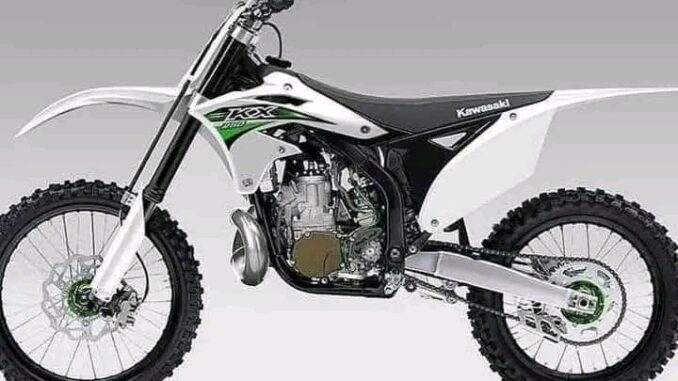
As of October 2023, Kawasaki has maintained a notably discreet approach regarding their latest developments in the realm of two-stroke motorcycles, leading many enthusiasts and industry observers to wonder whether the brand has chosen to go completely dark on this front. Historically, Kawasaki has been a significant player in the two-stroke segment, especially during the 1980s and 1990s, when models like the KX series set standards for motocross performance. However, in recent years, the focus has shifted heavily toward four-stroke technology, driven by emissions regulations, technological advancements, and market preferences.
**Current State of Kawasaki’s Two-Stroke Offerings**
In the present landscape, Kawasaki’s official communications and product catalogs show little to no mention of new two-stroke models or updates. The company’s lineup appears to be predominantly populated with four-stroke motocross, dual-sport, and off-road bikes. This absence has fueled speculation that Kawasaki might have pivoted away from two-stroke development altogether or is deliberately keeping its plans under wraps.
**Reasons for the Silence**
Several factors could explain Kawasaki’s reticence:
1. **Regulatory Environment:** Emissions standards worldwide are increasingly stringent. Two-stroke engines, known for their higher emissions compared to four-strokes, face regulatory hurdles that make development and sale more challenging in many markets. Kawasaki, like other manufacturers, might be choosing to focus on cleaner, more compliant four-stroke engines.
2. **Market Demand:** The demand for two-stroke bikes has waned significantly, especially in competitive motocross and enduro segments, where four-stroke technology dominates due to its improved power delivery and efficiency. Kawasaki might see limited return on investment in developing new two-stroke models.
3. **Technological Shift:** Advances in four-stroke engine design, including lighter frames, better power-to-weight ratios, and lower emissions, have made them more appealing. The industry’s focus has shifted toward these technologies, leaving two-strokes as a niche market.
4. **Strategic Focus:** Kawasaki may be reallocating its R&D resources toward electric and hybrid powertrains, which are viewed as the future of motorized transport. This strategic shift could explain the lack of recent updates on traditional internal combustion engines, including two-strokes.
**Historical Context and Rumors**
Despite the silence, there have been periodic rumors and industry whispers about Kawasaki’s potential return or development of two-stroke technology:
– **Vintage and Classic Markets:** Kawasaki still maintains a presence in the vintage and classic motorcycle markets, where two-stroke models like the KX250 and KX500 are highly collectible. However, these are remanufactured or restored models rather than new releases.
– **Patent Filings and Teasers:** Occasionally, patent filings or trademark applications hint at future projects. As of late 2023, no credible leaks or filings suggest Kawasaki is actively developing a new two-stroke model.
– **Industry Events:** Major motorcycle shows and industry expos over the past year have seen no Kawasaki announcements related to two-stroke engines. The company has instead showcased electric concepts and four-stroke models.
**Industry Trends and Kawasaki’s Position**
The overall industry trend indicates a decline in two-stroke motorcycle development, driven primarily by environmental concerns and technological progress. Manufacturers like Yamaha, Honda, and KTM have either phased out or limited their two-stroke offerings, focusing instead on four-strokes or electric solutions.
Kawasaki’s apparent silence aligns with this trend but also leaves room for speculation. Some industry insiders suggest that Kawasaki may be quietly working on a new two-stroke engine, possibly for niche markets such as vintage racing, emissions-compliant off-road riding, or even electric hybrid systems that mimic the characteristics of traditional two-strokes.
**What Could the Future Hold?**
While Kawasaki has not officially announced any plans, the future of two-stroke technology in the industry remains uncertain. Advances in emissions control, such as direct fuel injection and catalytic converters, have opened the door for cleaner two-stroke engines, which could potentially see a resurgence if manufacturers find a way to meet environmental standards without sacrificing performance.
Kawasaki’s silence could be strategic, waiting for the right technological breakthrough or market condition to re-enter the two-stroke segment. Alternatively, they might be focusing entirely on electric motorcycles, which are rapidly gaining ground.
**Conclusion**
In summary, as of late 2023, Kawasaki has indeed gone completely dark regarding new two-stroke models or updates. The lack of official announcements, coupled with industry trends, suggests that the company is either taking a long-term strategic pause or has shifted its focus entirely away from traditional two-stroke engines toward cleaner, more modern propulsion systems.
For enthusiasts hoping for a comeback, this silence is disappointing but not necessarily definitive. The motorcycle industry is dynamic, and technological innovations could change the landscape in the coming years. Until Kawasaki chooses to break its silence, the future of two-stroke Kawasaki motorcycles remains uncertain, leaving fans to speculate and hope for a surprise return down the line.
Leave a Reply